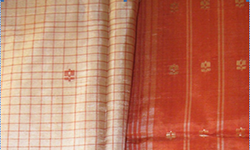
Art history/ Historiography, Entrepreneurship, Business Devt., Sustainability, Sustainable Devt.
CONTEMPORARY EMBROIDERIES OF RABARIS OF KUTCH: ECONOMIC AND CULTURAL VIABILITY
Frater, Judy
June, 2020
Monghiben Rabari is attending an exhibition and sale in Mumbai. Her traditional embroidery has taken her from Vandh, her village of mud huts and camels on the seacoast of Kutch to India’s most cosmopolitan urban metropolis. She is thrilled by the glittering bustle, and by the customers’ enthusiastic response. She deals directly with them, as a professional artisan. And not only do the customers buy; one woman is so impressed that she wants to learn embroidery. She engages Monghi as a teacher during the afternoon lulls of the exhibition.
Surely, we have succeeded in the transition from tradition to profession. Crafts have become viable both economically and culturally. Women are earning fair wages for their art, and also respect. I ask Monghi how she likes being a teacher.
“Sometimes it seems like all we DO is embroidery!” she exclaims in exasperation.
Thus Monghi provokes me to examine whether embroidery today is viable, economically or culturally, to the Rabaris who execute it?
Rabari Traditions
Traditionally, Rabari women practiced embroidery as an integrated part of their nomadic existence. Embroidery was an affordable aesthetic expression of community, sub-community and status within that community. Embroidery was portable, created wealth. A woman adorned herself and her household with her own efforts, utilizing time between more essential chores. The glittering pieces that a girl embroidered for her dowry were considered a contribution to the marriage exchange. Women worked as a...
This is a preview. To access all the essays on the Global InCH Journal a modest subscription cost is being levied to cover costs of hosting, editing, peer reviewing etc. To subscribe, Click Here.



